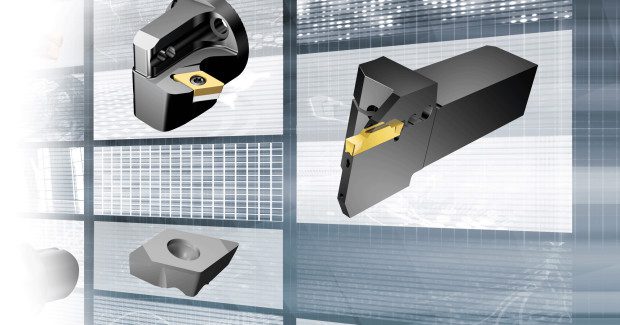Cutting Tools and Science Fiction
We are quickly moving from information technology to intelligent technology, toward a time when a worn cutting tool insert will know when it’s time to be replaced by a fresh one and will ask an available robot to get a new one and make the change.
Posted: January 11, 2015
We’re living in a time of rapid digitization, where computers and robots are capable of performing science fiction tasks. Automated concept cars now exist that can drive safer than you and I.
By utilizing advanced sensing technologies, smart algorithms and powerful microprocessors can make robots perform advanced logistic assignments and draw intelligent conclusions. You can verbally ask your smartphone a question and get a reliable answer back. That same smartphone probably has more computing power than Apollo 11 when it landed the first men on the moon.
Your smart phone may not yet answer all of your questions, nor will your present car take you anywhere without your involvement, but these sorts of technologies are developing rapidly and are gradually ready to be implemented in different consumer and industrial devices. These technology shifts that we are experiencing are an embryo of a broader industrial revolution, and even though we are still in the very beginning of it, the capabilities are improving quickly.
DRIVING FORCES FOR CHANGE
When the steam engine first appeared in the British cotton industry, many naysayers argued that it was foolish and expensive to invest in it, as the hydropower they were using at that time, was basically free of charge. The sceptics had to surrender, however, as flexibility and productivity were stronger motivators than the investment cost alone. Use of waterpower restricted the factories to the riverbanks, while the steam engine opened up for a more flexible location and higher output.
While the steam engine is usually considered to have launched the first industrial revolution, it was followed by the introduction of mass production through electricity in the second half of the 19th century and then by computerization in the late 20th century. Common to all three of these phases is that they opened up business for higher productivity and that enterprises that failed to join the revolution had a hard time catching up.
We are now on the verge of a fourth industrial revolution: Industry 4.0, that of intelligent technology.
FOURTH INDUSTRIAL REVOLUTION
Today’s growing world population and consumption pattern puts merciless pressure on the environment. In addition, food supply is not sufficient for everyone and we are running out of fossil energy resources. In order to survive this reality, we need to develop sustainable solutions that are economically beneficial and environmentally friendly. We need to act smarter, increase efficiency in everything we do, and optimize every step.
The fourth industrial revolution might be part of the answer to some of these challenges. What is the fourth industrial revolution? As the Wall Street Journal explained in June 2013, “The new industrial revolution is a wave of technologies and ideas that are creating a computer-driven manufacturing environment that bears little resemblance to the gritty and grimy shop floors of the past.”
This explanation doesn’t solely imply that machines and robots are taking over the heavy and dirty tasks that humans don’t particularly want anyway. There is a lot more to it. The vision is of smart factories, where every product controls how it is produced, resulting in a decentralized manufacturing system.
We are quickly moving from information technology to intelligent technology. Sensors embedded in objects are connected to networks that enable a future refrigerator to tell you to avoid the soft drink you crave for, because it knows that your body needs a carrot and two eggs. Products inside a factory will find their way independently through a production process, and a worn cutting tool insert will know when it’s time to be replaced by a fresh one and it will ask an available robot to get a new one and make the change.
THE INTERNET OF THINGS (IoT)
Among important enablers for this development is the radio frequency identification (RFID) sensors that can be embedded in an object, such as a T-shirt. These RFID sensors collect useful information about your heart rate. Connect the devices to the Internet and the information can be processed and acted upon.
This sort of technology can be used in basically all industries for increased sustainability, quality, safety, efficiency and profitability. One example is the oil and gas industry, where RFID can be used to collect information about the environment in the down hole to prevent uncontrolled releases of crude oil or natural gas from a well.
Another example is the use of a new technique called Smart grids for increasing sustainability is electrical grids. By collecting information about consumer behavior, electricity can be produced and distributed according to the analysis to improve the efficiency, productivity and profitability.
Gartner, the world’s leading information technology research and advisory company, predicts that there will be 26 billion IoT units in use by 2020, excluding PCs, tablets and smartphones. These objects and the systems they use that communicate with other systems shape the core of the fourth industrial revolution. The Internet of things is what will take your component through the entire production process and autonomously ensure that the manufacturing is performed flawlessly from start to end.
The digital universe – which is all of the data produced in the entire world – doubles every two years, increasing ten-fold from 4.4 trillion gigabytes in 2013 to 44 trillion gigabytes by 2020, according to a report by EMC and IDC. Thanks to all of this fast-growing online activity, such as social media and the Internet of things, the digital universe continues to grow exponentially. Wal-Mart alone now handles more than one million customer transactions each hour and imports the data into databases that are being used for smarter decision-making.
Companies that are good at collecting, analyzing and acting upon the business analyses of their operations will be able to improve everything from product development to the customer offer. It becomes increasingly important to create sustainable strategies for how to collect and store information – what to store, how to store it, and in what format. Today only a fraction of the available data is actually being analyzed to create business advantage. But, as previously stated, this is just the beginning of a new era of Big Data analytics.
NEW POSITIONS, NEW CHALLENGES
New techniques and communication make it increasingly easy for small companies and start-ups with limited budget to get their innovations to market. As was the situation in Britain in the early 19th century, flexibility is the key word today. Increasing demand for easily accessible customized products calls for an agile innovation process and new flexible manufacturing processes such as 3D printing. Product life cycles are becoming ever shorter and very few products will be exactly alike.
The industry needs smarter, leaner and agile factories, where faster and reliable decision making and intelligent data stream management are prerequisites. Additionally, a competence shift will be essential. To succeed, your staff will need to concentrate on innovative processes and smart product development rather than traditional tasks that are taken over by automation.
Your set of competitors will probably be different ten years from now. Small, agile start-ups have never in history had a better position to challenge large companies that are not as flexible and agile. How do you need to adjust?
At our company, for example, research and development has been fundamental since its start back in 1862, in the midst of the first industrial revolution. We now spend more money on R&D than any other company in the metal cutting industry and a substantial part of that budget is spent on new technologies and sophisticated systems because we strongly believe in the new industrial revolution.
We aim to help our customers and partners succeed with intelligent manufacturing. When machine tool makers, controller manufacturers and our common customers are ready for full-scale connectivity, we will have the required tools ready to help them free-up resources that can be used for innovations.
SMARTER CUTTING TOOLS
A first step in this direction is the introduction of the AdveonTM software that aims to embed product data, information and knowledge related to our cutting tools into the customer’s shop processes through their CAM system. This software is built on the cutting tool data standard ISO 13399 that we initiated. In other words, this is an open source system that allows the shop to work with tools from any supplier using the standard, guaranteeing the accuracy of all geometrical information.
http://youtu.be/H2Osyr0G5r4
This system makes it easier for the customer to prepare cutting tools from the latest updated information in their CAM environment so they can increase the efficiency in their planning process through an advanced smart tool library combined with an assembly functionality. Together with the experience and competence of the CAM programmer, the software streamlines and optimizes the planning and preparation.
This saves the shop time and secures their information quality needed in CAM programming today, but that is only the beginning. Looking ahead, this open source system will be a vital part of the comprehensive smart manufacturing systems that integrate manufacturing intelligence across the entire production operation.
Sources
- “The Second Machine Age,” Erik Brynjolfsson and Andrew McAfee, Norton, 2014.
- The Wall Street Journal.
- Gartner.
- SAS whitepaper: “Big Data Meets Big Data Analytics.”
- EMC Digital Universe with Research & Analysis by IDC.
- “TED Talk: Andrew McAfee: What Will Future Jobs Look Like.”
- McKinsey Global institute Podcasts: “Big Data.”
- McKinsey Global institute Podcasts: Internet of Things.
- Fw:Thinking podcast: “Internet of things.”
Martin Helgoson is the senior project leader of intelligent machining, Vahid Kalhori is the manager of intelligent machining, and Jan Edvardsson is a market analyst of product management for Sandvik Coromant US, 1702 Nevins Road, P.O. Box 428, Fair Lawn, NJ 07410, 800-726-3845, Fax: 201-794-5257, www.sandvik.coromant.com.













